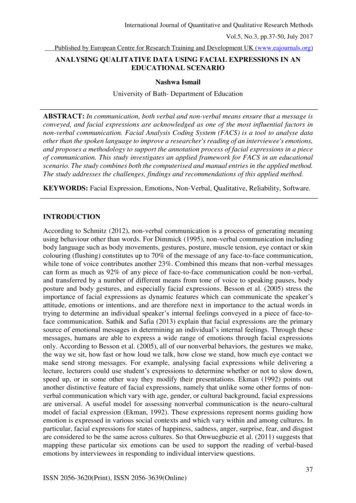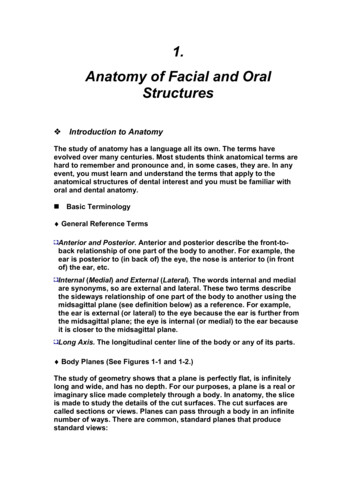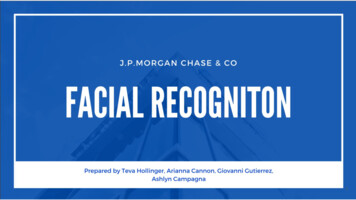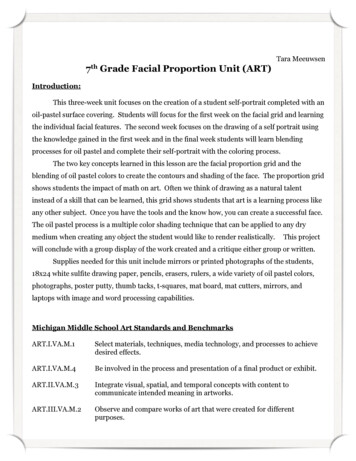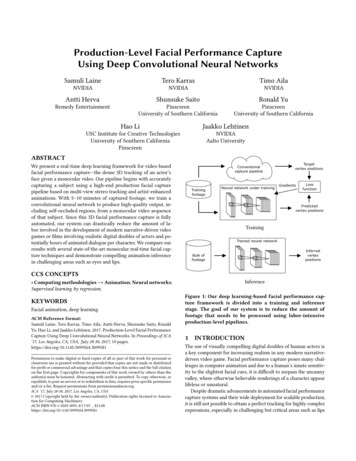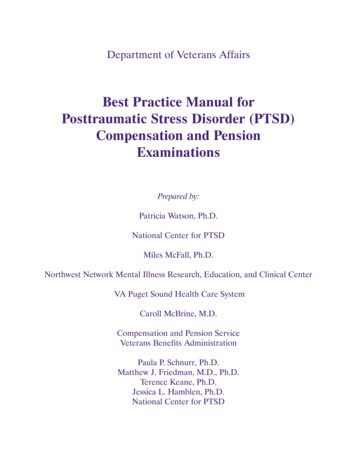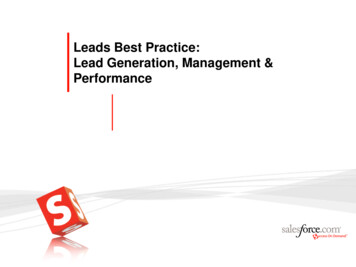
Transcription
ENFSI-BPM-DI-01 (vs.01)BPM for Facial Image ComparisonBest Practice Manualfor Facial Image ComparisonENFSI-BPM-DI-01Version 01 - January 2018
ENFSI’s position on Best Practice ManualsENFSI wishes to promote the improvement of mutual trust by encouraging forensicharmonisation through the development and use of Best Practice Manuals.Furthermore, ENFSI encourages sharing Best Practice Manuals with the whole ForensicScience Community which also includes non ENFSI Members.Visit www.enfsi.eu/documents /bylaws for more information. It includes the ENFSI policydocument Policy on Creation of Best Practice Manuals within ENFSI (code: QCC-BPM-001).Official languageThe text may be translated into other languages as required. The English language versionremains the definitive version.CopyrightThe copyright of this text is held by ENFSI. The text may not be copied for resale.Further informationFor further information about this publication, contact the ENFSI Secretariat. Please check thewebsite of ENFSI (www.enfsi.eu) for update information.
ENFSI-BPM-DI-01 (vs.01)BPM for Facial Image ComparisonBest Practice Manual for Facial Image ComparisonCONTENTSACKNOWLEDGEMENTS . 41.AIMS . 42.SCOPE . 43.DEFINITIONS AND TERMS . 54.RESOURCES . 65.METHODS . 96.VALIDATION AND ESTIMATING UNCERTAINTY OF MEASUREMENT . 167.PROFICIENCY TESTING . 178.HANDLING ITEMS . 179.INITIAL ASSESSMENT . 1710.PRIORITISATION AND SEQUENCE OF EXAMINATIONS . 1811.RECONSTRUCTION OF EVENTS . 1912.EVALUATION AND INTERPRETATION . 1913.PRESENTATION OF EVIDENCE . 2014.HEALTH AND SAFETY . 2115.REFERENCES . 2116.AMENDMENTS AGAINST PREVIOUS VERSION . 23APPENDIX A: EDUCATION AND TRAINING GUIDELINES FOR FACIAL EXAMINERS . 24APPENDIX B: FACTORS AFFECTING FACIAL APPEARANCE . 36APPENDIX C: OVERVIEW OF COMPARISON METHODS . 48AcknowledgementsReuben Moreton (Metropolitan Police Service, UK), Sergio Castro Martinez (Cuerpo Nacionalde Policίa, Spain), Niclas Appleby, Fredrik Eklof, Elisabet Leitet, Klas Brorsson Läthén (NationalForensic Centre, Sweden), Alice Towler (University of New South Wales, Australia andUniversity of York, UK) and Arnout Ruifrok (Netherlands Forensic Institute, Netherlands).Appendix A was produced as part of the CEPOL Knowledge Exchange Programme 2015between Metropolitan Police Service, UK and National Forensic Centre, Sweden.3/50
BPM for Facial Image Comparison1.ENFSI-BPM-DI-01 (vs.01)AIMSThis Best Practice Manual (BPM) aims to provide a framework for procedures, quality principles,training processes and approaches to forensic facial image comparison (FIC). This BPM can beused by member laboratories of the European Network of Forensic Science Institutes (ENFSI)and other forensic science laboratories to establish and maintain working practices in the fieldof forensic facial image comparison that will deliver reliable results, maximize the quality of theinformation obtained and produce robust evidence. The use of consistent methodology and theproduction of more comparable results will facilitate interchange of data between laboratories.The term BPM is used to reflect the scientifically accepted practices at the time of creating. Theterm BPM does not imply that the practices laid out in this manual are the only good practicesused in the forensic field. In this series of ENFSI Practice Manuals the term BPM has beenmaintained for reasons of continuity and recognition.2.SCOPE2.1GeneralThis BPM addresses the processing, examination and comparison of imagery depicting facesand the evaluation of findings in a forensic context.This BPM is aimed at facial image examiners and assumes prior knowledge in the discipline offacial comparison. It is not a standard operating procedure and addresses the requirements ofthe judicial systems in general terms only.BPMs are overarching document that describe recommended working practices for a process.BPMs sit above detailed standard operating procedures, which describe the laboratory specificmethod of a process. The recommendations within the BPM are not mandatory and will beupdated to reflect new empirical research where appropriate.Facial comparison is widely used in other areas of law enforcement, such as when gatheringintelligence on persons of interest, during the process of a criminal investigation, verifying aperson’s identity for access control or reviewing the output of an automated facial recognitionsystem. These types of comparison are defined as facial review by the Facial IdentificationSubcommittee of OSAC, in document ASTM E2916 Terminology for Digital and MultimediaEvidence Examination [1] as:facial review, (1) the review of a facial recognition (FR) system candidate list toidentify a possible match; (2) the one-to-one comparison (verification) conducted in ahigh-throughput environment (for example, border crossing).Generally facial reviews are considered to be non-evidential facial comparisons, staff whoconduct these comparisons may be trained facial reviewers but not to the level of facialexaminer. Although facial reviews are currently outside the scope of this BPM the principlesdiscussed for forensic facial image comparison are still relevant to facial review.For the purpose of this document the term imagery will be used to describe both still images andmoving video.Activity level reporting is outside the scope of this document.4/50
ENFSI-BPM-DI-01 (vs.01)BPM for Facial Image Comparison2.2LimitationsThis BPM does not address the following aspects of facial identification: The recognition of familiar faces The use of automated facial recognition algorithms Age-progression of faces Facial reconstruction Facial composites Determining subject age and ethnicity from images Forensic artistryThis BPM also does not address comparison of other parts of the human body, object andclothing comparison or gait analysis from imagery. Future versions of this BPM may addressother areas of comparison and also reviewing results from automated facial recognition systems.The restoration of corrupt or incomplete digital data, physical repair of storage media, repairof analogue media and complex imagery enhancement (e.g. frame integration techniques)are outside the scope of this BPM. Where relevant and appropriate these tasks should beundertaken by examiners with competency and training relevant to that field.This BPM will address the authentication of imagery insofar as to determine if the imagery hasbeen provided in its original format. Authentication methods to determine if imagery has beenmanipulated are outside the scope of this BPM.3DEFINITIONS AND TERMSFor the purposes of this BPM, the relevant terms and definitions given in ENFSI documents, theInternational Laboratory Accreditation Cooperation (ILAC) G19 “Modules in a Forensic ScienceProcess” [ILAC G19:08/2014], as in standards like International Standardisation Organisation(ISO) 9000 [ISO 9000:2005], ISO 17000 [ISO/IEC 17000:2004], 17020 [ISO/IEC 17020:2012]and 17025 [ISO/IEC 17025:2005] apply.For definitions of terms specific to facial image comparison used in this BPM refer to thedocument: ASTM E2916 Terminology for Digital and Multimedia Evidence Examination [1].For definitions of terms specific to image processing and enhancement used in this BPM pleaserefer to the ENFSI BPM for Forensic Image and Video Enhancement (ENFSI-BPM-DI-02) [2](Note that at the time of writing this BPM (ENFSI-BPM-DI-01), the BPM for Forensic Imageand Video Enhancement (ENFSI-BPM-DI-02) is in draft and a date of publication has not beenfinalised).For definitions and terms related to the evaluation of evidence and reporting conclusions refer tothe ENFSI Guideline for Reporting Evaluative Opinions [3].Other specific terms used in this BPM are:Questioned image: Imagery in which the identity of the depicted subject is contested oruncertain. Questioned imagery is typically captured in uncontrolled conditions.Reference image: Imagery in which the identity of the depicted subject is known and has beenverified. Reference imagery is often captured under controlled conditions.5/50
BPM for Facial Image Comparison4.RESOURCES4.1PersonnelENFSI-BPM-DI-01 (vs.01)4.1.1Facial Image ExaminersThis BPM is specific to facial examiners conducting FIC examinations. FIC examinations aredefined as follows by FISWG [4]:‘The task of facial examination includes, but is not limited to, a rigorous one-toone analysis, comparison, and evaluation of controlled and uncontrolled imagesfor the purpose of effecting a conclusion. Examiners in this situation have to drawon a larger foundation of knowledge, skill, and ability to accurately reach theirconclusions. Additionally, the articulation of the scientific and legal basis for theexpression of conclusions for many forensic, intelligence, or law enforcementpurposes requires an even more advanced level of training to include an expandedset of knowledge, skills, and abilities above the level of basic concepts.’Throughout this document the terms ‘facial image comparison’ and ‘FIC’ will be used to refer toall aspects of the facial comparison examination.4.1.2Testing Innate AbilityThe laboratory should implement a facial comparison testing programme as part of itsrecruitment scheme, to gauge examiner ability before training. There is a wide range in innateability when comparing unfamiliar faces [5], [6]. Such a testing scheme can be used to highlightindividuals with high innate performance for recruitment as facial examiners and enrolment insubsequent training and mentoring.Throughout training regular testing and evaluation of trainee performance should be conductedusing ground truth facial comparison tasks. These tasks should cover the range of imagery thatwill typically be encountered in casework. Empirical research has demonstrated that providingtrainees with feedback on facial comparison tests improves trainee ability [7].4.1.3TrainingIn order to undertake FIC, examiners must be trained and competent in appropriate proceduresand have specialist knowledge in relevant topics. The following is a list of recommendedcompetencies for facial examiners. Which competencies are required will depend upon theoperational requirements of the agency or organisation for whom the examiner works and thetypes of casework undertaken. Not all of the points will be relevant to every agency ororganisation and not all topics are required to become a competent facial examiner in aspecific situation.A detailed list of topics and references for the education and training of facial examiners can befound in Appendix A.New examiners should have a training plan devised prior to commencing training and beassigned a mentor to guide them through their training and provide feedback on tasks. Theorganisation’s Quality Management System (QMS) should describe how examiners are to betrained and tested to achieve competency and how competency should be maintained.6/50
ENFSI-BPM-DI-01 (vs.01)BPM for Facial Image Comparison4.2EquipmentIT hardware and software is utilised for the viewing, processing and possible enhancement ofimagery for FIC. Such hardware and software should be fit for purpose and where possiblevalidated for its intended use. The laboratory should keep an up-to-date list of all hardware andsoftware used including identifying information such as the version or build number of softwareand the serial number of hardware.There is a wide range of software and hardware that can be used for facial image comparison,these can be broadly defined as:Hardware Computer hardwareStorage and archiving systemGraphical output devices (e.g. displays or printers)Graphical input devices for analogue media if appropriate (e.g. scanners, digitalcameras, video capture cards)Graphical output devices, such as display monitors and printers, should be calibrated todetermine the accuracy of the outputted image. Likewise graphical input devices should also becalibrated to ensure that the digital image generated captures information at the required levelof detail.Software General purpose image processing toolsGeneral purpose video editing toolsImage and video data analysis toolsGeneral and manufacturer specific (proprietary) viewing toolsThe software used to view and process digital imagery should be validated insofar as possiblefor its intended purpose. This validation should, at the bare minimum, determine if the processresults in any visual loss of quality to the displayed or outputted imagery and
BPM for Facial Image Comparison ENFSI-BPM-DI-01 (vs.01) 1.AIMS This Best Practice Manual (BPM) aims to provide a framework for procedures, quality principles, training processes and approaches to forensic facial image comparison (FIC). This BPM can be used by member laboratories of the European Network of Forensic Science Institutes (ENFSI)

